7 Harvesting and post-harvest handling
7.1 Harvesting your market-sized prawns
Basically there are two methods of harvesting: culling (sometimes called cull-harvesting) and draining (drain-harvesting). The time to harvest depends partly on growth rate and the size of animals you want to sell. This, in turn, depends on your market requirements. It also depends on the pond management technique chosen. Cull-harvesting is used to har vest market-sized animals from the pond at intervals and removes the faster growing prawns. Annex 8 gives further information on size management. The rest of the prawns are caught when the ponds are drained at the end of the grow-out cycle.
In tropical ponds cull-harvesting usually starts 5-7 months after PL have been stocked, or sooner if juveniles have been stocked. After cull-harvesting commences, you should totally seine each pond once per month or partially seine it twice per month (i.e. seine half the pond twice per month or all of it once per month). Take out the market-sized animals and sell them. Keep the smaller ones and soft-shelled animals in the pond for fur ther growth. After about 8-11 months, drain the pond and sell the whole harvest. In areas where water supply is short, some farmers utilize water drained during complete harvest ing in other ponds to conserve water but, if you think of doing this, beware that you may be transferring a water quality or disease problem from one crop to the next. This practice is not recommended in this manual. After drain-harvesting, you can either prepare, refill and restock the pond immediately, or keep it empty until you have enough water available again and/or (in temperate zones) until water temperatures become suitable again for rear ing.
Cull-harvesting is not very efficient in removing harvest-sized prawns. It does not maximize the total quantity of marketable prawns which could be achieved, partly because some marketable animals remain in the pond longer than necessary and partly because the smaller prawns do not get the maximum chance to grow faster than they would have if there were no dominant prawns left behind. In theory, the best management system would be to totally harvest the pond, remove all the dominant animals, and restock the others in the same or a different pond. Various management strategies to maximize pond utilisation and production rate have been described, for example the modified batch system developed in Puerto Rico, as mentioned earlier. A four-pond multi-stage rotational scheme, which includes the re-stocking of undersized prawns following harvest, is described by Karplus, Malecha and Sagi (2000). Some handling losses occur during the animal transfers neces sary for these more complex management systems. These types of management may be feasible in large farms with many available ponds. However, cull-harvesting, followed by total drain-harvesting before re-stocking with a new batch, remains the most practical management scheme for small freshwater prawn farms.
You should carry out all harvesting operations as early as possible in the morning when it is cooler, to avoid having water levels too low when the sun is directly overhead. If you allow the water to become shallow, temperatures can quickly rise to danger level and the prawns will be subjected to low dissolved oxygen levels. This will cause many mortali ties before you can finish harvesting all the animals.
CULL HARVESTING
In this technique a seine net is pulled through the pond to remove market-sized animals. The net may be a simple seine or one constructed especially for the purpose (Annex 7), usu ally made of monofilament nylon, and provided with floaters, sinkers and sometimes a bag. The size of the seine you use depends on the size of pond you are using it for. Nets which are 2.5 m high with a length equivalent to 1.6 times the pond width are suggested. The mesh you choose depends on the size of animal to be marketed. Although stretched knot mesh sizes of as low as 0.7 inches (1.8 cm) are sometimes used where there is a market for small prawns, the usual recommended mesh size is 1.5-2 inches (3.8-5 cm).
Care must be taken to ensure that the bottom of your seine is kept on the bottom of your pond. If you do not, many prawns will escape beneath it. Preferably you should pull the seine down the long axis of the pond (this is why rectangular ponds of 30 m maximum width are preferred) so that the ends of the net are pulled along the banks of the pond (Figure 83). Seining different halves of the pond once every two weeks avoids disturbing the whole of the pond at once.
The amount of prawns collected by the seine should not exceed that quantity which can be rapidly taken out of the seine, and transferred to a live box, a cage, or an impound ed area for sorting. Many prawns, especially smaller ones, die when the bag of a bag seine is lifted out of the water if the quantity is too great. One way to ensure that the seine does not get overloaded because a whole pond is being seined is to stretch two seines across the middle of the pond. Firstly, while one seine is staked in position to retain the prawns in one half of the pond, pull the other seine to the end of the pond and harvest it. Then pull the first seine to the opposite end of the pond (Figure 84).
Ponds which are too wide to harvest by pulling each end of the seine down the long sides of the pond can also be seined but not so efficiently. You will have to repeat the sein ing operation several times, keeping one end stationary and pulling the other end in a semicircular fashion (Figure 85). If some of your labourers beat the surface of the water with sticks it will discourage the prawns from escaping the open end of the net as it is pulled toward the bank. Circular ‘breeding’ depressions are often seen in drained freshwa ter prawn ponds. These interfere with seining operations because large males can use them to evade the seine. Pond bottoms should be kept as even and smooth as possible. You should remove these depressions between rearing cycles.
Generally speaking, the more men you have available to help with seining, the more
FIGURE 83
You can cull-harvest your ponds by seining the pond towards one end seine is pulled in this direction
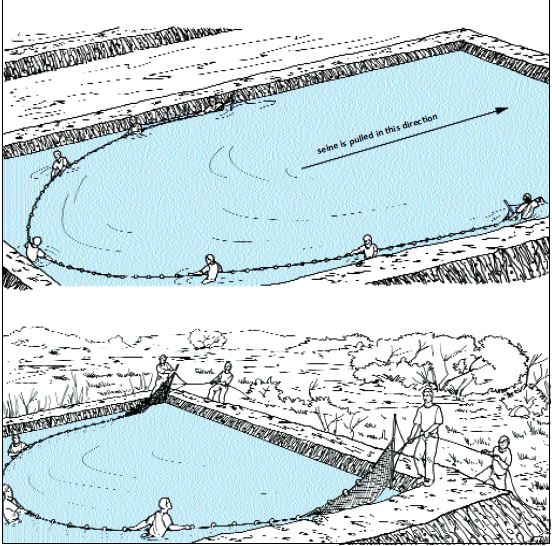
SOURCE: EMANUELA D’ANTONI
efficiently you can perform this task (provided there is one clear leader!). Three to five peo ple can pull a seine net through a 30 m wide pond and seven to ten men can cope with a 50 m wide pond. A single-seined 0.2 ha pond takes about two to three hours to cull harvest using three or four people. Some farms claim that they can cull-harvest and sort the prawns caught from a 1 ha pond with 5 people in less than 2 hours but this may not max imize the catch of harvest-sized animals. You can put a temporary harvesting enclosure within the pond during seine-harvesting (Figure 86). This enables you to keep the prawns alive as long as possible (you may be going to sell them alive) and to sort them into differ ent categories.
Transfer the prawns that you have seined to a holding tank or net (Figure 87) quick ly. From this, you can sort them into different categories (by size, sex, berried females, etc.) to suit your market. Figure 88 shows a holding net being held near the pond inlet to main
FIGURE84
In a longer pond you may find it easier to carry out seining operations with two nets
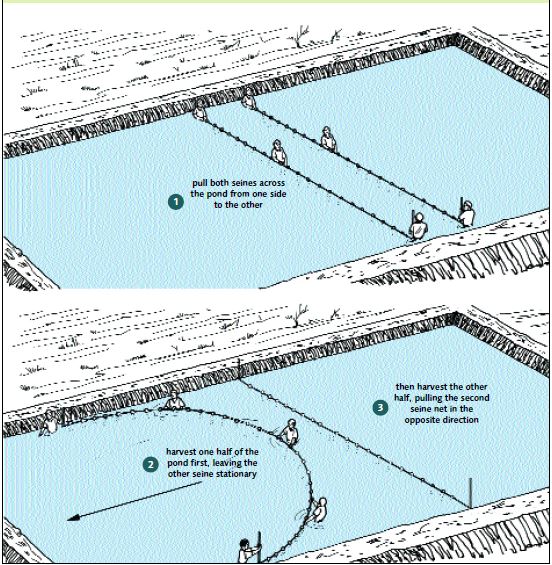
SOURCE: EMANUELA D’ANTONI
tain good water quality, and therefore high survival. Market sized animals should be retained for sending to the market; smaller animals should be returned to the original or to another pond. The measurement of market-sized animals during the sorting operation can be done by a quick check of total length. Tying rulers to the operators hands is a use ful way of training them to do this but experienced harvesters quickly learn to judge sizes quite accurately. Remember that cull-harvesting is a good time to examine the health of your prawns (Figure 89).
Further details of seining techniques are contained in another FAO manual (FAO 1998,) which also illustrates other methods of partial harvesting, such as cast nets and lift nets.
FIGURE85
Larger ponds may also be cull-harvested by making several seining operations; beating the water surface with a stick can help to keep the prawns from escaping from the open end of a seine before it is brought to the side of the bank
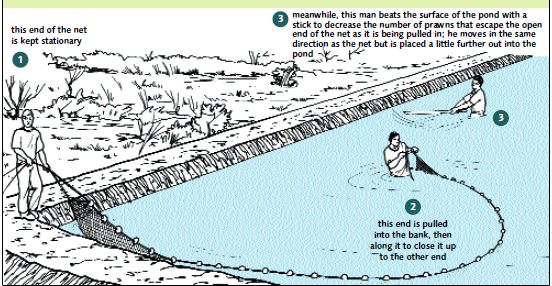
SOURCE: EMANUELA D’ANTONI
DRAIN HARVESTING
The method and efficiency of drain harvesting depends on the design of the pond. As with any other method of harvesting, speed is important and harvesting should start very early in the morning while the temperature is cool. You can partially draw down the pond water level during the night before harvesting commences.
If your pond has a ‘monk’ or sluice gate structure for drainage, you can include a har vesting sump (catch basin) in front of the gate (Figures 90 and 91) or outside the pond. Details of drain harvesting structures are given in another FAO manual (FAO 1998). Efficient total harvesting can best be achieved through the addition of a catch basin with in a drainable pond. As you drain the pond, prawns will accumulate in the basin. You must be careful to avoid oxygen deficiencies in the sump; you can prevent this by providing
Figure 86
Sorting prawns while seine harvesting
Figure 87
Market sized freshwater prawns can be kept alive while harvesting continues (Martinique)
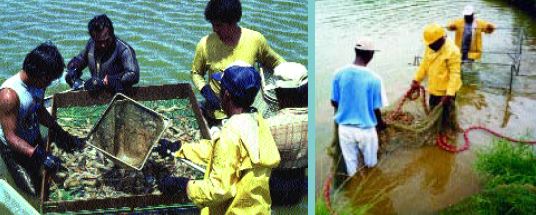
SOURCE: SPENCER MALECHA SOURCE: MICHAEL NEW
Figure 88
Prawns destined to be sold alive need clean and well oxygenated water to keep them in peak condition (Martinique)
Figure 89
Cull-harvesting or sampling is an opportunity to check the health of your prawns

SOURCE: MICHAEL NEW SOURCE: DENIS LACROIX
aeration or by having a continuous flow of new freshwater through the catch basin. Minimizing prawn stress (e.g. caused by low dissolved oxygen levels, high temperatures, crowding) during harvesting is extremely important. Having the correct outlet structure dimensions becomes particularly and obviously important when drain harvesting takes place. If the outlet pipe of the pond is too small, the pond will take much too long to drain (Table 14) and many of your animals will die before harvesting is completed. If your pond has been properly constructed, very few prawns will become trapped on the pond bottom during draining. In ponds with added substrate, these habitats can be left in place. The prawns will move out of the substrate to the catch basin as the water level drops.
FIGURE 90
An internal harvesting sump can be used for Macrobrachium rosenbergii during drain-harvesting

SOURCE: EMANUELA D’ANTONI
Figure 91
Harvesting Macrobrachium rosenbergii from ponds with an internal harvesting sump (Brazil)

SOURCE: WAGNER VALENTI
If your pond does not have a monk or sluice gate you will have to drain it by pumping. Prawns must be prevented from entering the pump by means of a screen. Long-tail pumps, as shown in Figures 60 and 61, can be used. If you are harvesting this type of pond you will need to catch most of the prawns by multi ple seining of the pond while draining takes place (Figure 92). As the water level gets low, many prawns will retreat
Figure 92
Cull-harvesting freshwater prawns several times before drain harvesting increases the yield of market-sized animals in your crop (Martinique)
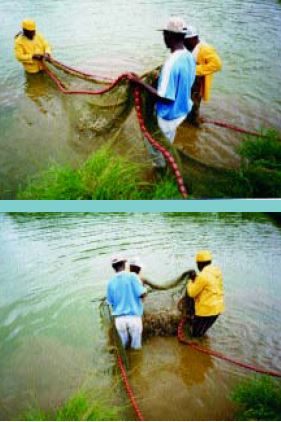
SOURCE: MICHAEL NEW
into the mud or become stranded in isolated pools of water. At this stage there is no sub stitute for catching by hand (Figure 93). If you have problems with stranded prawns at this time you will wish that you had been more careful to construct your pond with a good slope towards the drain and a well compacted, smooth surface. Another typical result of poor pond drainage is the target that stranded prawns provide for birds. Birds love harvest time (Figure 94)!
In temperate regions the harvesting of the total pond population of prawns must occur before water temperatures drop below 17°C. However, some animals may attain mar ketable sizes 4 to 6 weeks before final harvest. 2-3 cull harvests may be beneficial to spread the marketing season over a longer period.
Good handling and process ing really begin at the pond bank. You need to take special care during harvesting to avoid the ‘mushiness’ which processed freshwater prawns have often been accused of.
This effect is not unavoidable; it is caused by poor harvesting and processing. Do not allow your prawns to become ‘stacked up’, either in a net or in a harvest basin; this causes damage to the internal organs which results in poor quality prawns when sold. If you are not going to sell your prawns live, you should immediately wash them in clean water, kill them in a mixture of water and ice at 0°C, and then wash
Figure 93
The last few prawns may have to be caught by hand, especially when the pond does not drain well (India)
Figure 94
Bird predation causes problems during drain harvesting (Hawaii)
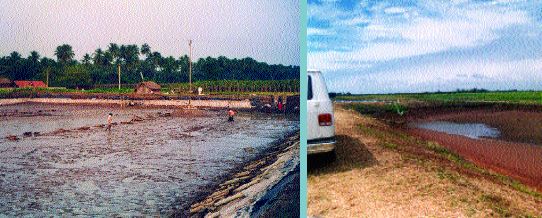
SOURCE: STEPHEN SAMPATH KUMAR SOURCE: SPENCER MALECHA
them in chlorinated water (5 ppm active chlorine). This process, which preserves product quality, must be carried out near the pond, usually on the pond bank. Transporting live prawns to processing facilities before this treatment is carried out is not recommended because some prawns will die during transport and become ‘mushy’. No subsequent treat ment can improve the texture of such prawns. When you are planning to sell the prawns live, take special care to reduce stress and minimize harvesting damage as much as possi ble, to ensure long-term post-harvest survival. You can achieve this by aerating or supply ing a little clean water to the harvest basin (see Figure 91) and holding the prawns in clean, aerated holding tanks at temperatures preferably of about 20-22°C.